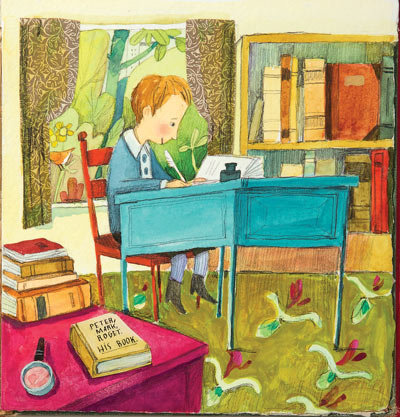Putting a playful spin on school, these picture books depict life in the classroom as a grand adventure, filled with good friends, fun activities and teachers that are wise beyond words.
Fresh recruits feeling less than intrepid about maneuvering the school days that lie ahead will be heartened by Planet Kindergarten by Sue Ganz-Schmitt and Shane Prigmore. The first day of class takes on the dimensions of a cosmic mission in this imaginative tale, as a courageous young boy leaves behind the comforts of home to explore an unknown zone: kindergarten! In class, he acclimates to an atmosphere that’s undeniably intergalactic, with a mission-control intercom and far-out friends, including a pair of pink sister-twins with long white hair, and a tall, thin figure whose bulging head is hidden inside a purple hoodie. Crisply rendered and a bit retro, Prigmore’s brilliant digital illustrations make this space-age expedition extra special.
A TEACHER TRANSFORMED
A mischievous pupil butts heads with a stern instructor in My Teacher Is a Monster! (No, I Am Not.) by acclaimed author and illustrator Peter Brown. Bobby, a boy with a light-socket shock of hair and a penchant for paper airplanes, has a rocky relationship with his teacher, Ms. Kirby. In class she addresses him shrilly as “Robert” and—after an unfortunate airplane incident—deprives him of recess. Small wonder Bobby views her as a monster! Ms. Kirby is indeed a scary sight—a creature-teacher with green skin and fangs. But when Bobby runs into her in the park, the encounter (which involves ducks, a flying hat and—yes—a paper airplane) is surprisingly pleasant. As he gets to know the real Ms. Kirby, her monster facade fades. Brown’s nifty India ink, watercolor and gouache illustrations reward careful scrutiny. This one’s destined to become a school-season staple.
A BIG IMPRESSION
A master of many genres, Neil Gaiman tackles school anxiety in Chu’s First Day of School, the delightful follow-up to his bestseller Chu’s Day. This time, the pint-sized panda is fretting over his first-ever school experience. When the big morning arrives, he’s greeted by a kind teacher (a bespectacled bear) and a menagerie of animal-students, who introduce themselves and explain what they love to do: Robin likes to fly, while Pablo, the monkey, gets a kick out of climbing. Uneasy Chu sits in silence until a cloud of chalk dust forces him to share his own special ability. We won’t reveal what happens next, but suffice it to say, Chu blows his classmates away! This panda has plenty of personality thanks to artist Adam Rex, whose rollicking illustrations, executed in oil and mixed media, have depth, dimension and detail. Immanently adorable, Chu is the perfect pal for readers suffering from first-day phobia.
This article was originally published in the August 2014 issue of BookPage. Download the entire issue for the Kindle or Nook.








 2015 BookPage Summer Reads
2015 BookPage Summer Reads











